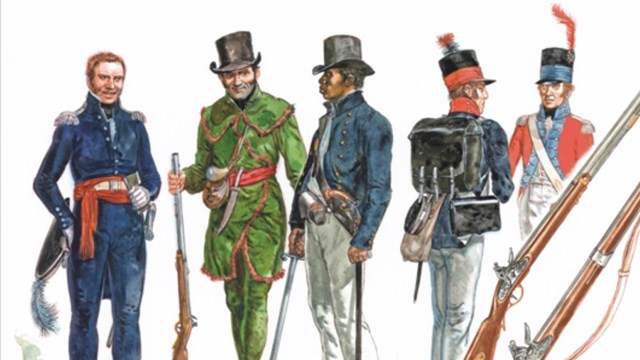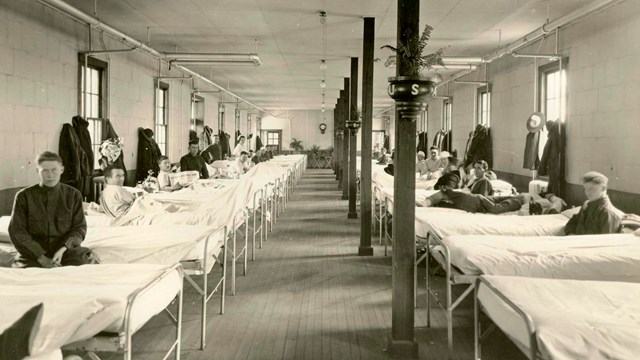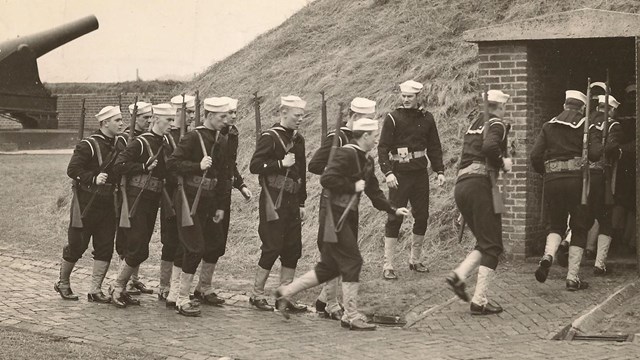|
Fort McHenry would never have been made prominent enough to become not only a National Monument, but also the only Historic Shrine in the National Park Service if not for the people who came through its walls. Beginning with its namesake, James McHenry, the people affiliated with the fort are what makes its history truly remarkable. Active from the early 19th Century through the First World War, and reactivated in the Second World War, thousands of people came through the fort, telling stories of valor, struggle, and compassion. War of 1812Completed in 1802, the first real test for Fort McHenry was the War of 1812. Serving as a regular garrison for coastal defense for the entrance of Baltimore’s port, key figures such as George Armistead would be stationed at the fort during the war. Armistead quickly intertwined Baltimore’s community into the fort when in 1813 he approached local seamstress, Mary Pickersgill, and requested two flags to be made for the fort, including one so large that “the British will have no trouble seeing it from a distance.” When Baltimore was threatened in the Fall of 1814, the fate of the citizens and their city fell into the hands of those defending Fort McHenry. Many people of all backgrounds, enslaved, free- African Americans, women, soldiers, etc., came together to assist in the Battle of Baltimore. The successful defense of Fort McHenry inspired Maryland lawyer Francis Scott Key to write “The Defense of Fort McHenry,” later called “The Star-Spangled Banner,” today’s National Anthem. Civil WarStill an active military instillation in 1861, Fort McHenry found itself at the forefront of the secession crisis at the start of the American Civil War. After the Pratt Street Riots occurred in April of 1861, in which citizens of Baltimore with pro-secession sentiments attacked United States forces on their way to Washington D.C., martial law was enforced in the state of Maryland. To prohibit the possibility of Maryland (a slaveholding state) joining the Confederacy, which would leave D.C. surrounded, pro-secession leaders were arrested and held in Fort McHenry. What was once a symbol of “the land of the free,” became a symbol of the removal of the writ of habeas corpus for the political prisoners held there. American soldiers found themselves pointing artillery towards the Patapsco river for coastal defense, but also towards the city of Baltimore to ward off insurrection. Confederate prisoners of war filtered through the site as well, with a notable surge of thousands temporarily being held on the site following the battle of Gettysburg. For its role in the Civil War, Fort McHenry had been nicknamed “the American Bastille.” World War IBy the time the United States was entering the First World War in 1917, Fort McHenry was becoming outdated as a coastal defense instillation. However, it took on a new role as United States General Hospital No. 2. Comprised of roughly 100 buildings, the soldiers who entered the fort largely were no longer active, and instead recovering from wounds received in Europe. Hundreds of doctors performed lifesaving surgeries and experimental reconstructions to give wounded soldiers a relatively normal life after service. Reconstruction nurses worked tirelessly to help rehabilitate soldiers on the site. Their work was no less heroic than the many defenders of the fort who had come before them, although times of terror were still seen at the fort, specifically during the 1918 Spanish Influenza pandemic in which soldiers “dropped like flies.” 
People of the War of 1812
Details on the important people involved with Fort McHenry during the War of 1812. 
People of the Civil War
Learn about the people that came through the fort during the American Civil War. 
The People of World War I
The stories of the many people that made up Fort McHenry's busiest time period! 
The People of Other Eras
Fort McHenry was active for over 100 years! Learn the stories of the many different people of the several eras of activity! |
Last updated: March 15, 2024
